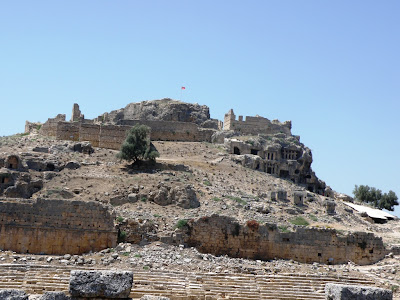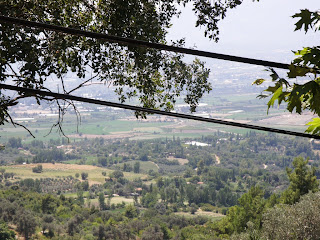 |
| Ottoman Fortress towers over the ancient city |
On the road out to Saklikent we had passed a sign indicating a turn to go to ancient Tlos. The place Elisabeth wanted to go to for lunch was supposedly also out in that direction somewhere. So off we went to search out both Tlos and the restaurant. Our Lonely Planet guidebook for Turkey did not have much information about Tlos:
 |
| Looking up from tomb side to the Ottoman Fortress |
"On a rocky outcrop high above a pastoral plain, Tlos was one of the most important cities of ancient Lycia. Its prominence was matched only by its promontory; so effective was its elevated position that the well-guarded city remained inhabited until the early 19th century."
 |
| Amphitheater is now off-limits to tourists |
We saw all the typical things associated with both a Lycian city and a Greek or Roman town. The usual acropolis, a stadium seating 2,500, an amphitheater with 34 rows of seating, and two baths, along with Lycian rock tombs and sarcophagi, all topped with an Ottoman fortress. Guess we are becoming a might jaded because we already have seen so many of these ancient Roman and Lycian sites. The only thing particularly striking to us about Tlos was the excellent location overlooking an enormous valley.
 |
| Rock tombs overlooking Xanthos valley |
Tlos is situated on the eastern side of the enormous Xanthos valley. (We visited ancient Xanthos in May or June 2012 and wrote a blog about it at that time, so I will forgo explaining anything more about Xanthos here.) The websites I checked stated that Tlos was dominated by its acropolis. I beg to differ. Tlos is dominated by the Ottoman fortress high above the acropolis. The views of Xanthos valley are breathtaking.
 |
| Ruins of the ancient city of Tlos |
As one of the most powerful of the six principal cities of Lycia, Tlos was important to the Roman empire. It was a member of the Lycian Federation from the 2nd century BC. It is one of the oldest and largest settlements of Lycia and was known as 'Tlawa' in Lycian inscriptions. Two wealthy philanthropists were responsible for much of the building in the 2nd century AD. Eventually it was inhabited by the Ottoman Turks.
 |
| Ruins of the entrance gate to the acropolis |
http://www.lycianturkey.com/legendary_heroes.htm
 |
| Think this might be the Bellerophon tomb |
 |
| Or, maybe it is one of these? The first one looks more like a temple tomb to me. |
(Note: there are boat tours offered in Fethiye going to Olympos. We probably will not go on one of these tours. Especially since I cannot locate specifically where this Olympos is supposed to be located.)
 |
| Wonder what this was for. Looked like it once connected to something across what is today's road. |
As we drove away from Tlos we passed this stone formation higher on a small hill opposite from the Lycian rock tombs carved into the mountain beneath the Ottoman Fortress. Obviously these stones are not a natural formation but we could not figure out what their use might have been in ancient times. Across the roadway there was a large, very tall tumble of square-ish stones almost completely covered in vegetation. It appeared to me that at some point something connected from the stones in this photo to what was a large structure slightly lower on the hillside (and now across today's roadway). Excavation work is not active at Tlos now. Who knows if those structures will ever be identified.
 |
| Looking down at valley from the odd stone formation |
 |
| Cutest little girl selling mom's wares |

No comments:
Post a Comment
Your comment will be posted after we confirm that you are not a cyber stalker.